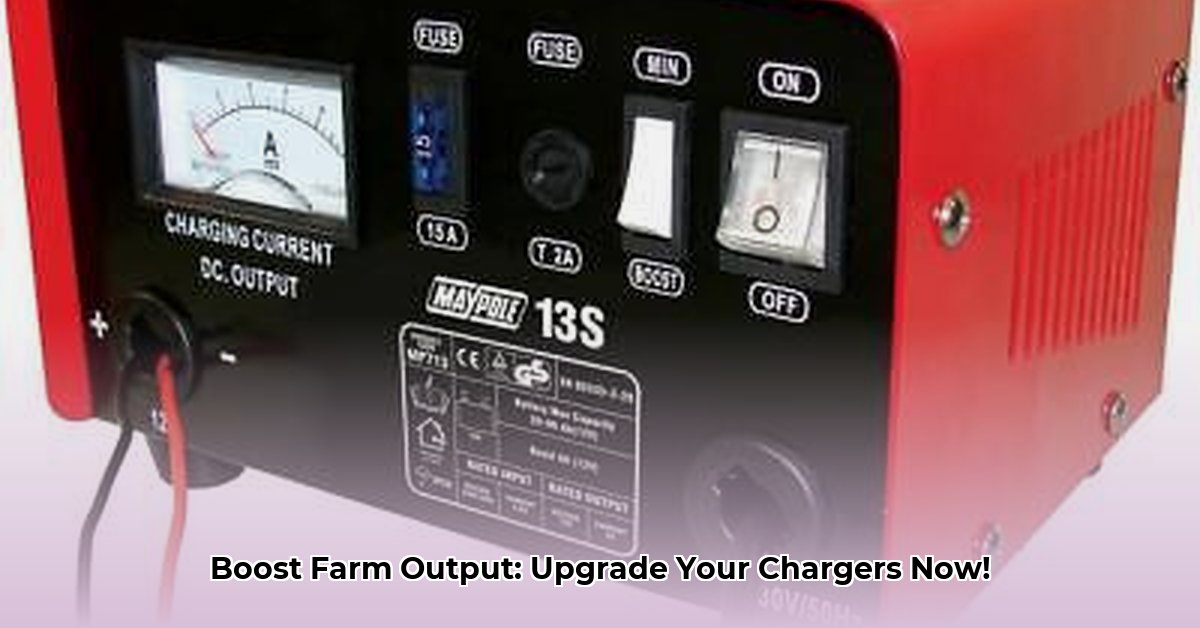
Farming is evolving, and reliable power is key. The increasing electrification of farm equipment means mastering battery technology is no longer optional—it's essential. This guide focuses on optimizing your Tractor Supply battery chargers to keep your operation running smoothly. We'll cover charger types, selection, safe charging practices, troubleshooting, and the future of sustainable agricultural power. For more on tractor batteries, check out this helpful resource: New Holland Batteries.
Understanding Your Battery: The Foundation of Farm Power
Before selecting a charger, understand your battery. Think of it as choosing the right engine. A mismatch leads to inefficiency and downtime. The most common type is lead-acid (a reliable, cost-effective option), but lithium-ion batteries are gaining popularity, offering faster charging and longer lifespans, although at a higher initial cost.
Crucially, you need to know your battery's voltage (12V or 24V) and amp-hour (Ah) rating. The Ah rating is like your fuel tank's capacity: a higher number translates to more runtime before recharging. High-demand equipment needs higher Ah batteries and a charger capable of handling that capacity. A wrong choice here means costly downtime later. Don't underestimate this vital step.
Choosing the Right Tractor Supply Charger: A Personalized Approach
Tractor Supply offers various chargers, each with its pros and cons. Let's analyze them to find the best fit for your farm:
Standard Chargers: These are budget-friendly and simple to use, ideal for overnight charging. They offer a reliable, if slower, charging process; think of them as steady, dependable workhorses.
Fast Chargers: For quick recharges, fast chargers are the solution, perfect for urgent situations. However, they need careful monitoring to prevent battery overheating. Always check compatibility with your battery's specifications.
Smart Chargers: These high-tech chargers offer features like automatic voltage sensing and multi-stage charging for maximizing battery lifespan. While more expensive, they represent a long-term investment in battery health.
Here's a comparison table to assist your decision:
| Charger Type | Charging Speed | Cost | Battery Health Monitoring | Best Use Cases |
|---|---|---|---|---|
| Standard | Slow (8-12 hours) | Low | Basic | Overnight charging, infrequent use |
| Fast | Fast (1-4 hours) | Moderate | Limited | Quick top-offs, emergencies |
| Smart | Optimized | High | Advanced (voltage, temperature monitoring) | Maximizing battery life, long-term investment |
Safe Charging Practices: Prioritizing Farm Safety
Safety is paramount. A simple mistake can have serious consequences. Follow these steps meticulously:
Power Down: Before connecting anything, ensure all equipment connected to the battery is off and disconnected.
Clean Connections: Dirt and corrosion impede efficient charging and spark hazards. Clean battery terminals with a wire brush or terminal cleaner.
Correct Connections: Connect charger clamps firmly to terminals: red (+) to positive, black (-) to negative. Double-check!
Monitored Charging: Don't leave a charger unattended, especially fast chargers. Watch for overheating or unusual smells.
Safe Disconnection: After charging, disconnect clamps. Remove the black (-) clamp before the red (+) clamp. This prevents accidental short circuits.
Doesn't this sound comprehensive enough to ensure your farm's safety? Taking these steps can prevent a potentially dangerous situation.
Troubleshooting and Battery TLC: Maintaining Peak Performance
Regular battery maintenance extends lifespan and saves money. Inspect terminals for corrosion or damage; clean as needed.
Common problems and solutions:
Slow Charging: Check for corroded terminals, a faulty charger, or a failing battery.
Charger Malfunction: Check the fuse first; it's an inexpensive fix. If the problem persists, seek professional help.
Battery Failure: Signs include reduced runtime, slow performance, or a swollen battery case. Replacement is necessary.
Dr. Emily Carter, Professor of Chemical and Biomolecular Engineering at Princeton University, emphasizes, "Regular maintenance, including cleaning and inspection, is crucial. Ignoring these steps can lead to premature battery failure and significant downtime."
The Future of Sustainable Farm Power: Embracing Innovation
Farm power is rapidly evolving. Advancements in battery technology offer longer-lasting, more powerful batteries. Renewable energy sources are increasingly used for charging, making farming greener. Tractor Supply will continue adapting, providing sustainable solutions.
Investing in quality chargers is an investment in your farm's efficiency and longevity. By following these guidelines, you'll ensure your equipment remains powered up and running smoothly. Remember, well-maintained batteries lead to a thriving farm.